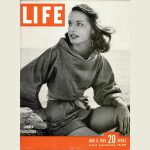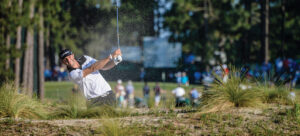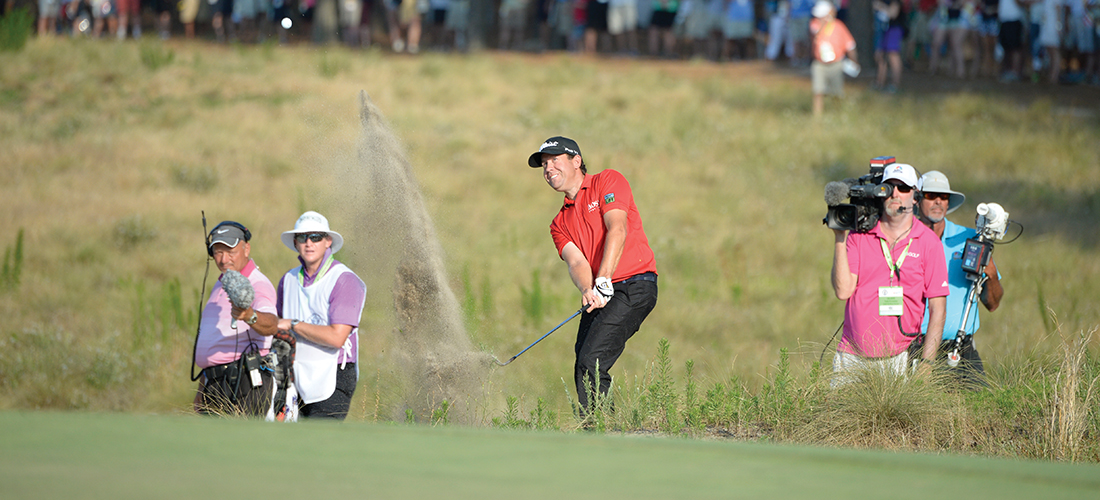
Erik Compton makes his mark at Pinehurst
By Jim Moriarty • Photographs by Joann Dost
We are captivated by winning. Utterly enthralled. Driven to distraction, or maybe delusion. To Vince Lombardi, winning wasn’t everything, it was the only thing. Twenty-five years ago, a boyish Tiger Woods offered the wisdom of youth: “Second sucks, and third is even worse.” But things are not always what they seem. Sometimes second can be mistaken for heartbreak when, in fact, it’s heartwarming, even life-affirming. That’s the way it was seven years ago, here, on Father’s Day, the last day of a most uncommon U.S. Open.
To some, the whole thing may have seemed a little boring. Soft-spoken Martin Kaymer shot 65-65 the first two days, the loudest whisper (and still the lowest 36-hole score) in the 120-year history of the championship. Taking a six-shot lead into the weekend, he played three-dimensional chess against Donald Ross across the great architect’s finest creation, Pinehurst No. 2, making whatever moves seemed prudent to keep disaster at arm’s length. Sudden catastrophe seemed the only thing that could prevent the then 29-year-old German from adding another major title to the PGA Championship he’d won in 2010. He put a sleeper hold on the field and won by eight, a performance as different from the magical drama of Payne Stewart’s knockout punch delivered in Pinehurst’s first U.S. Open in 1999 as a Buick commercial is from King Lear.
When the dust from the course’s newly restored natural areas had settled, the two players who were closest in Kaymer’s rearview mirror were Rickie Fowler, the then 25-year-old hotshot dressed in the bedazzling orange of his alma mater, Oklahoma State; and Erik Compton, the 187th ranked player in the world. Both Fowler and Compton knew that, barring a cataclysmic failure by the leader, they would spend Sunday playing for second, which is where they wound up, tied at one under par, joining Kaymer as the only players in red figures for the week.
Fowler had finished in the top five in the Masters in April. He’d been on a big stage before. Compton not so much. He’d been a seriously accomplished amateur. A Walker Cupper. An All American at the University of Georgia, where his roommate was an odd duck named Bubba Watson. Just about the biggest thing he’d ever won as a professional was the 2011 Mexico Open on what is now the Korn Ferry Tour.
Compton wasn’t supposed to be up there, sitting next to Kaymer at the prize-giving. Everyone who knew the story of his two heart transplants knew that. And yet, there he was, having earned his spot competing on one of the sport’s grandest stages, across one of its most demanding tests, with a pure silver medal as tangible proof to those he loved and those who loved him — and to himself — that, for a time, he belonged among the best. That the gift of life, bestowed twice, had been honored. That his third heart, beating with the thump of an athlete, had achieved a personal best. That he had climbed higher than anyone would have ever imagined possible. It was a most uncommon week indeed.
If getting there is supposed to be half the fun, Compton used up his full quotient finding his way to Pinehurst. After missing the cut in The Memorial and depressed about the state of his game, Compton sat down at a table in the Muirfield Village clubhouse with the host, Jack Nicklaus. “Jack said, ‘If you get into the Open at Pinehurst, you’re going to have a great tournament there.’ He said that to me,” Compton recalls. “It was weird.”
What was weirder was how he did it. One of the toughest U.S. Open sectional qualifiers is played the Monday after The Memorial, that year won by a young Hideki Matsuyama, this past April’s Masters champion. The qualifier is traditionally loaded with tour players. In 2014 there were 120 players for six spots over 36 holes at Scioto Country Club and Brookside Golf and Country Club. Compton got the last spot in a five-way playoff for three slots.
“We had a rules official come up to us with five holes to go and ask if we wanted to know where we stood,” says Victor Billskoog, Compton’s caddie. “We were two out of getting in. We get to 17 and we’re still two out. He hit a 4-iron 218 into the wind and it comes up an easy 60 feet short and I’m going, ‘Oh, boy.’ He drains it. Now, we figure we’re one down. Then he holed a bunker shot on 18. That was how we got into the playoff.”
Afterward, they celebrated in the parking lot. “It was dark,” Compton says. “It was the longest day I’ve ever played of golf.”
Billskoog, who now sells Miami real estate, had a simpler view. “It was a helluva ride to get in,” he says.
Almost from the moment Compton, Billskoog and Erik’s teacher, Charlie DeLuca, saw No. 2’s barren, natural areas and brown fairways, they had a collective, comforting sense of dejà vu. DeLuca is the director of golf at Melreese Country Club, a public course near Miami International Airport. “We had sprayed Melreese dead because they were getting ready to redo the greens and fairways,” he says. “So, for two weeks before the Open we were playing on burnt fairways and burnt greens, which very nicely resembled the extremely fast fairways and extremely fast greens at the U.S. Open. Everything was so glass fast at Melreese that when we got there it wasn’t so bad.”
Neither was Compton’s golf swing. In one of his nine-hole practice rounds Compton wound up in a money game with the South Africans, Ernie Els, Charl Schwartzel and Louis Oosthuizen, major champions all. “I told them I was the Mexican Open champion,” says Compton with a grin. At the end of the nine, it was the South Africans, including his friend Els, going to their wallets. “I remember them pulling out the 50s and 100s,” says Compton.
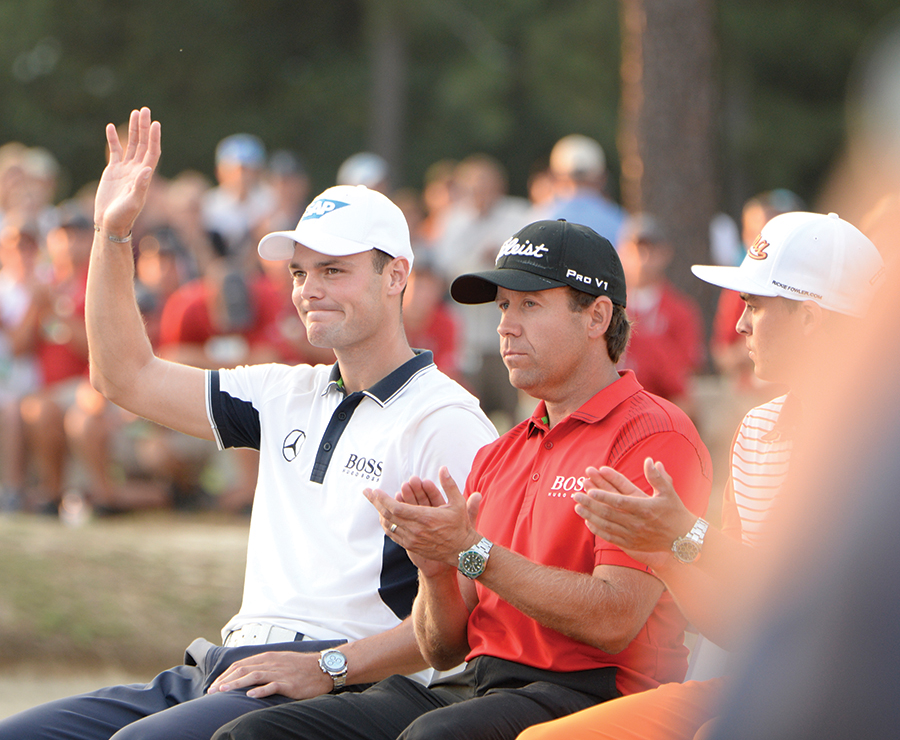
Monday through Wednesday, Compton and DeLuca lasered their way around No. 2, plotting the landing areas that presented the least risk. “We really did a whole lot of game planning how we were going to go through this golf course,” says DeLuca. “Whether we were 10 under or 10 over we were going to stay in that game plan.” Central to the plan was hunkering down off the course. “We were going to stay in our group of the caddie, myself and Erik. We weren’t going to let anybody from the outside in our group. We were going to stay very quiet and try hard not to get distracted. His parents were there and we made a deal with them where they weren’t going to see him except while we were playing.”
Rest is a big part of Compton’s equation. It has to be. “We’ll do things like go practice real early, go home at the middle of the day and take a nap, go back at the end of the day and play nine holes. That’s what we did at the Open,” says DeLuca. “You go on a two-week trip with Erik, you can guarantee he’s sick three days. He just is, between the medication, the stress. The slightest little thing can send his body into a loop. And it can go either way. His heart can race up to 160 beats a minute for no reason and then it can flat out crash and burn for no reason. Physically, his body really isn’t supposed to be going through this adrenaline, up-and-down lifestyle he lives. He wasn’t even supposed to play golf after his second heart attack. The day he got out of the hospital he showed up on the driving range at our place and said, ‘I need to get playing again.’”
The entire Compton contingent, parents, caddie, teacher, were staying at the Springhill Suites on U.S. 15-501. DeLuca drove the courtesy car to the course every day. And every day he played the same song, volume up, on his cellphone. It was Aloe Blacc’s “The Man.”
Well, you can tell everybody
Yeah, you can tell everybody
Go ahead and tell everybody
I’m the man, I’m the man, I’m the man
“He’d blast it. It was like brainwashing,” says Compton.
“We played the damn song every single day,” says Billskoog. “It was like the gasoline to the boat that week.”
While Kaymer was hydroplaning across Pinehurst No. 2, Compton was puttering along. Two over the first round, two under the second. Even par is never bad in a U.S. Open, unless the leader is setting scoring records. “With the pressure situation, playing in the U.S. Open and the weather is hot, I’m just glad to be done right now,” Compton said on Friday night after comfortably making the cut.
So deeply was Compton into his cocoon, he couldn’t even recall who he played with on Saturday (Francesco Molinari), when he and Fowler posted the low rounds of the day, a pair of 67s. After playing his middle two rounds 5 under par, Compton was still five shots behind Kaymer but in control of his game. “He was striking his irons as pure as it gets. His distance control was just on fire,” says DeLuca.
His caddie saw something more. “He just had something I hadn’t seen before,” says Billskoog. “They have something special when it’s a week like that. He had a confidence that I’d never seen. I felt like he walked a little bit different, like he spoke to me just a little bit different. He was on and he had it every single day.”
Compton was to be in the next to last pair on Sunday, playing with Henrik Stenson. “I was a huge fan of his,” says Compton. “We’re good friends now but he probably doesn’t know that. I was like, ‘Wow, this guy’s a monster.’”
In an effort to kill time Saturday night, DeLuca and Billskoog talked Compton into hanging out at the hotel pool. “We had a late tee time and we purposely didn’t let him go to bed at 9 o’clock like he would like to do,” says DeLuca. “We spent a good hour, hour and a half down at the pool laughing and giggling like 12-year-old kids. It was just an incredible experience. It really was.”
On Sunday morning, one reporter was allowed inside the bubble. “I got a little upset with a bunch of the press because all they would ever ask him about was his second heart attack,” says DeLuca. “That’s his story. I know it’s very important, but I don’t need Erik reliving his second heart attack 10 times before we tee off on Sunday.”
Compton was readier than DeLuca realized. “Erik’s warm-up routine is about 48 minutes long. We got to the range and he hit about six shots with irons, didn’t even hit a driver or a wood, and he turned around and looked at me and said, ‘You know, I’m hitting it great, let’s go putt.’ My jaw about hit the ground. We just kind of hung out on the putting green and talked for about 30 minutes while he putted. It was the most nervous I could have been for him and he seemed to be ungodly calm.”
Kaymer played the first nine holes in 1 under par, effectively slamming the door on any chasers. Compton was keeping pace but No. 2 was never going to give up the kind of low round it would take to catch the German. For his part, Stenson was struggling. “He was pissed about his own game but at the same time, he was rooting for me,” says Compton. “I’ve found that twice in my career with different guys. I know he wanted to beat me and he wanted to win the tournament but he wasn’t going to win — no one was going to beat Kaymer.”
Birdies on the eighth and 10th holes had the gallery chanting “USA! USA!” At one point Stenson looked at Compton and said, “I can see they’re not here to watch me today.”
Compton bogeyed three of his last eight holes. “The pressure coming down the back nine on Sunday, it was immense. I made some bogeys, but everybody was making bogeys,” he says. At the 18th, however, he made memories instead, the kind that, for him, are every bit as magical as the ones Payne Stewart left behind on the very same spot.
Compton missed the 18th fairway to the right. “The ball was sitting in a depression so he couldn’t get any contact with the club on the back of the ball,” says Billskoog. “We said we were going to hood an 8-iron and basically try to top it, try to get in the front bunker on an uphill lie, which is exactly what he did.”
From there Compton had a long bunker shot. If he goes over the green, he’s looking at double bogey, maybe worse. He asked his caddie for a 9-iron. “I didn’t say anything,” says Billskoog. “I had sunglasses on and I closed my eyes for a good five seconds. Sure enough, he filleted that thing.”
The low, spinning shot Compton played confused the crowd. At first they gasped, then as the ball checked inside 10 feet, they cheered. When he made the putt, they roared.
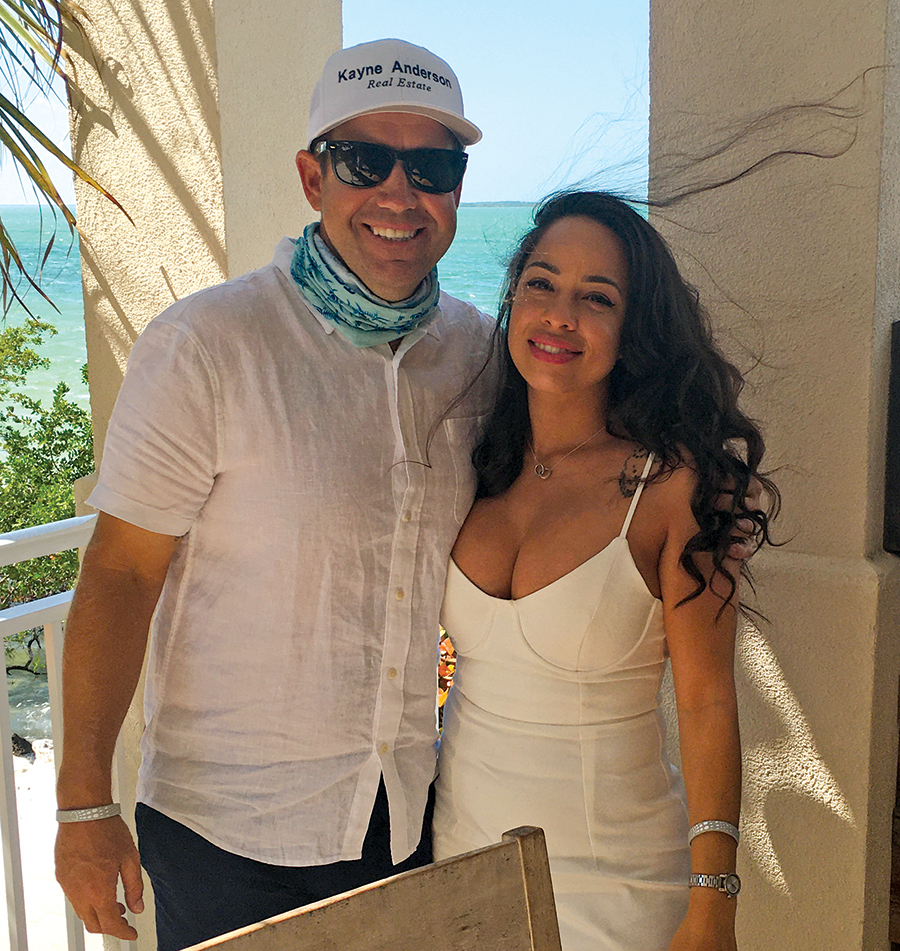
All week, the player and caddie were doing a ballet on the greens, reading putts separately from in back of the ball, then behind the cup, then trading places. As they were walking past each other on the 18th green, Compton looked at Billskoog and said, “Hey, Vic, I got this one. Don’t worry.” Compton told him to look around, soak in the moment. “This is something you’ll remember for the rest of your life,” he said, and holed the putt.
When he came off the course, second place secure, Michelle Wie — who would win the Women’s U.S. Open the next week — was among the people congratulating Compton because he’d just gotten into the Masters, a perk and a salve for a runner-up.
Off to the side, some spectators with a sense of Southern hospitality had helped Peter Compton, Erik’s dad, push forward so he could watch his son finish. “He was in front of the crowd, the crowd went crazy. It was like a movie,” Peter says.
When Peter Compton couldn’t negotiate the zealous security surrounding the presentation ceremony, he wandered down to the player and family hospitality tent. “I walked in and I said, ‘You know, I need a beer.’” The staff was breaking down but they found one for him. There was one other person in the tent with the same idea. “I said to him, ‘I’m so happy, my son just came in second.’ And he said, ‘Yeah, my son came in fourth.’” It was Brooks Koepka’s father, Bob. His son would win two U.S. Opens and two PGA Championships in the next five years.
“I never thought I was going to win the Open,” Erik says. “I was just trying to play as good as I could on every hole. Obviously, it was a great week for me. It means a lot to me. It’s the biggest thing I’ve done in my golf career. It was just such a winning experience for me, my family, I think the transplant world.” A world of people made whole through the grace of others, a world helped by his eponymous foundation, his time visiting hospital wards, his example.
In moments of reflection, Compton honestly doesn’t know if he overachieved or underachieved as a player. He knows there’s world class ability in a body that’s been through world class trauma. Only Compton knows what it has taken to do what he’s done. There’s no template, no suitable comparison.
“I’ve had a decent, small career in golf,” he says. “It’s hard to know if I outdid myself with everything I’ve been through or if I could have done more. I’m one of the more recognizable golfers in the world with the least amount of achievement.”
He ponders the unknowable in a life that revolves around it. Compton is currently the 971st ranked player in the world. He’s got full status on the Korn Ferry Tour and would like to make one last run at the big tour, but he’s 41 now and has no delusions that competitive golf gets easier with age. He’s been divorced and recently remarried. He spends his days giving golf lessons at Melreese and shuttling his 12-year-old daughter, Petra, to school and to all those other things that 12-year-old daughters do, and wishing he had more time to hook redfish in the Everglades.
The Open will be back in Pinehurst in three years. Compton would like to be there but doesn’t know whether his game or his body will allow it. “Do I think the chances of my getting back there are stacked against me? Absolutely,” he says. “I’ll know more in a year and a half where I stand with my game. I’m prepared to play as long as I can.”
But the golf is only part of the equation. He had his first heart transplant when he was 12. That heart began to fail 15 years later. The attack came while he was fishing. He drove himself to Miami’s Jackson Memorial Hospital. Ran a toll booth on the way. Called his parents to say goodbye. The doctors managed his condition until he received his second transplant in 2008, when he was 28. There is a shelf life for a transplanted heart, but the timetable is unknowable. One transplant recipient lived 33 years with a donated heart. The average is more modest.
“That’s always in the back of my mind, yeah, what’s next?” he says. “What can you do? You’ve just got to make the best of it. Nobody has a crystal ball. If we all knew what our departure date is we’d all live a different life, wouldn’t we?”
Or would we? On Father’s Day 2014, after all the prize-giving and interviewing was over, the Compton party partied on. Every day that week, Peter and Erik’s mother, Eli, had eaten at Fratello’s (now Napoli), just down the highway from their hotel. The owner then, and now, is Salvatore Doria. Sal’s a real Brooklyn paisan who moved from Raleigh to Pinehurst in 1979. He saved seats at the bar for Peter and Eli every night and, though he was supposed to be closed that Sunday night, he threw his arms and his restaurant open for their celebration. A painting of Frank Sinatra hangs on the wall like a monochromatic Mona Lisa. Peter Compton is a retired Royal Caribbean executive. He’s the guy who took the Ice Capades and Broadway shows to sea. He began his career as a cruise ship crooner. That night he and Sal belted out Sinatra tunes together.
That’s life
That’s what all the people say
You’re riding high in April, shot down in May
But I know I’m gonna change that tune
When I’m back on top, back on top in June. PS


